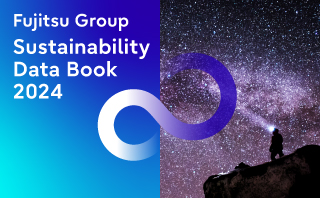-
Sustainability at Fujitsu Group
- Sustainability Management in the Fujitsu Group
- GRB(Global Responsible Business)Goals and Achievments for FY2022
- GRB(Global Responsible Business)Goals for FY2025
- Fujitsu's accessibility
- Stakeholder Engagement
- United Nations Global Compact
- SDG-related Activities in Fujitsu
- External Recognition and Awards
-
Global Responsible Business
- Environment
-
- Environmental Management
- The Fujitsu Group Environmental Vision on Climate Change
- Living in Harmony with Nature (Conservation of Biodiversity)
- Environmental Action Plan
- Environmental Data
- Environmental Communication
- Environmental Social Activities
- Disposal and Recycling of ICT products
- Environmental Considerations in ICT Products
- Governance
-
Data and Documents
- Fujitsu Group Sustainability Data Book 2024
- Social, Governance and Environmental data
- Independent Assurance Report

- GRI Standards / United Nations Global Compact (UNGC) principles Comparison Table
- SASB Standards Comparison Table
- Sustainability Information Disclosure Framework
- Link to regions responsible business reports
- Contact
- Sitemap
Climate Change
External Trends
Accelerated Controls on GHG Emissions are Required for Carbon Neutrality
The COP 21 Paris Agreement, adopted in December 2015, set out a long-term, shared worldwide goal to hold “the increase in the global average temperature to well below 2°C above pre-industrial levels” and pursue efforts “to limit the temperature increase to 1.5°C above pre-industrial levels.”, as well as the goal of carbon neutrality (net zero emissions) by the second half of this century (2050). Since then, efforts to achieve a carbon-neutral society have been accelerating on a global scale. The COP26 Glasgow Accords further solidified the 1.5°C target adopted under the Paris Agreement, elevating it to the standard for global climate change measures.
The Task Force on Climate-related Financial Disclosures (TCFD) was established in December 2015 by the Financial Stability Board, which members comprise central banks, financial regulatory authorities and finance ministries from major countries. The TCFD requests companies to use multiple climate scenarios to evaluate the climate-related risks and opportunities to their business and to assess and disclose the financial impact. Various international initiatives have also been launched, such as the Science Based Targets initiative (SBTi), which calls for corporate emissions reduction targets set to meet the 1.5℃ trajectory, and RE100, which calls for companies to source 100% of the electricity they use from renewable energy. Furthermore, CDP (*1), which runs the global disclosure system for investment that takes into account Environmental, Social and Governance (ESG) factors, requests that companies reduce GHG emissions by at least 2.1% year-on-year through voluntary efforts.
- (*1)CDP:
An international not-for-profit organization providing the only global system for companies and cities to measure, disclose, manage, and share vital environmental information. CDP works with major institutional investors around the world to encourage companies to disclose their impact on the environment and natural resources and to adopt measures that mitigate the impact.
Fujitsu Group Position
GHG Emissions Reductions are a Critical Issue for the Fujitsu Group
The Fujitsu Group, as an entity with global operations, is fully aware that climate change is a serious worldwide issue that spans national and regional boundaries. For example, disasters triggered by climate change can disrupt procurement, logistics and energy supply networks, which in turn interrupts the process of supplying materials and energy to business sites. Furthermore, delays in responding to societal and legislative requirements to reduce GHG emissions may impact product manufacturing, service development, etc., potentially leading to the loss of business opportunities.
Since launching the Fujitsu Group Environmental Action Plan, we have treated the reduction of GHG emissions as a critical issue and strived to achieve the defined targets.
The majority of the GHG emissions generated by the Fujitsu Group derive from purchased electricity, rather than the combustion of oil or gas. In particular, the energy consumption for cloud computing, IoT, and network communications continues to rise. To curb energy consumption and reduce GHG emissions, the Fujitsu Group conducts regular checks at its factories, data centers, and offices.
Approach under the Fujitsu Group Environmental Action Plan (Stage XI)
Strengthen Efforts to Achieve Carbon Neutrality
In May 2017, the Fujitsu Group formulated the FUJITSU Climate and Energy Vision, its medium- to long-term environmental vision. In August of the same year, the company obtained SBT validation for 2°C-aligned GHG emissions reduction targets. The SBTi aims to significantly reduce greenhouse gases over the medium to long term by encouraging companies to set voluntary GHG emissions reduction targets based on scientific knowledge compiled by organizations such as the IPCC (*2). Given the accelerating global trend toward carbon neutrality, the Fujitsu Group reviewed its position and revised its target to reduce GHG emissions from business sites in FY2030 from 33% to 71.4% below FY2013 levels. On April 15, 2021, this revised figure was successfully validated as a 1.5°C-aligned target by SBTi. To accelerate the global community’s journey to carbon neutrality, including within our supply chain, Fujitsu has pledged to expand our use of renewables to achieve net-zero GHG emissions (*3) for our own operations by FY2030, and across our entire value chain (Scope 1, 2, 3) by FY2040.
In June 2023, our net-zero by FY2040 target obtained “Net-Zero Target validation” under the SBTi standard.
Working backwards from these GHG emissions reduction targets, we developed the Fujitsu Group Environmental Action Plan (Stage XI) to implement our environmental targets for FY2023-2025. To achieve carbon neutrality, we are aiming for at least 50% of the energy used by our businesses to be from renewable sources by FY2025, with a target of 100% by FY2030. At the same time, we are working towards achieving net-zero GHG emissions across the entire value chain through measures such as identifying the environmental impacts of our suppliers and promoting emissions reductions, and by further reducing energy consumption of Fujitsu products.
In April 2021, in anticipation of Japan’s future transition to renewable energy, the Fujitsu Group switched to 100% renewable energy at our largest facility, the Fujitsu Technology Park (formerly, the Kawasaki Plant), which is now our flagship model. This commitment continued in April 2022 when Fujitsu Australia signed the Group’s largest ever Renewable Energy Power Purchase Agreement (PPA), securing approximately 47% of its power consumption for FY2023 from renewable sources. Beyond green power and renewable energy certificates, Fujitsu is investing in power sources with additional potential (such as PPAs), and leveraging advanced ICT technologies to accelerate the adoption of renewable energy across society.
- (*2)Intergovernmental Panel on Climate Change (IPCC):
An organization established in 1988 by the United Nations Environment Programme (PDF) (UNEP) and the World Meteorological Organization (PDF)
(UNEP) and the World Meteorological Organization (PDF) (WMO) with the aim of providing comprehensive assessments of human-induced climate change and its impacts, together with adaptation and amelioration measures from scientific, technological and socio-economic perspectives.
(WMO) with the aim of providing comprehensive assessments of human-induced climate change and its impacts, together with adaptation and amelioration measures from scientific, technological and socio-economic perspectives. - (*3)Net zero:
The elimination of greenhouse-gas emissions through emissions reductions of at least 90% by the target year and removing the remaining 10% or less through measures such as reforestation or Direct Air Capture (DAC) of CO2 in the atmosphere.
RELATED LINKS
Actions and targets related to climate change initiatives under the Fujitsu Group Environmental Action Plan (Stage XI)


